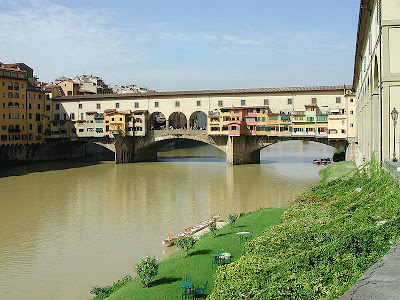 |
| Ponto Vecchio in the 1880s. |
Ponte Vecchio ("Old Bridge") in Florence is without doubt one of the world's most famous bridges. And old it is; the first version of the bridge spanning the Arno at its narrowest point is mentioned in a document from A.D. 996.
The bridge has always hosted shops and merchants, and it is said that the nowadays not so uncommon economic concept of bankruptcy originates here:
When a merchant could not pay his debts, the table on which he sold his wares (the "banco") was physically broken ("rotto") by soldiers, and this practice was called "bancorotto" (broken table; possibly it can come from "banca rotta" which means "broken bank"). Not having a table anymore, the merchant was not able to sell anything.
The photo above shows Ponte Vecchio in the 1880s. When one compares it with the contemporary image below, it is evident that there have been a few minor changes, although the bridge - fortunately - basically looks the same.
 |
| A contemporary photo of Ponte Vecchio (wikipedia) |
PS
Did you know that Ponte Vecchio plays a - not entirely happy - role in one of Puccini's most beloved arias "O, Mio Babbino Caro (Oh, My Dear Papa) from his opera "Gianni Schicci":
Oh my dear papa,
I love him, he is handsome, handsome.
I want to go to Porta Rossa
To buy the ring!
Yes, yes, I want to go there!
And if my love were in vain,
I would go to the Ponte Vecchio
And throw myself in the Arno!
I am anguished and tormented!
Oh God, I'd like to die!
Papa, have pity, have pity!
Papa, have pity, have pity!
Georges Prêtre, Orchestre National de France, 1965
No comments:
Post a Comment